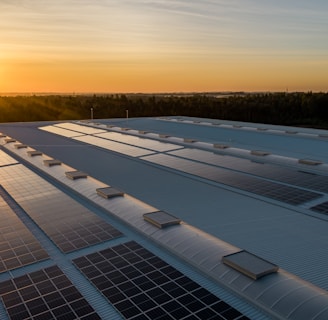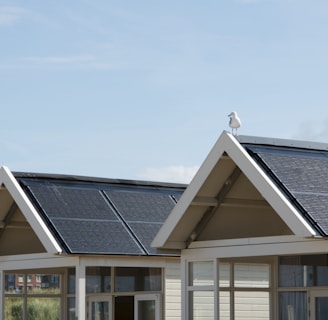Sol Energy: Benefits and Disadvantages
Discover the benefits and challenges of solar energy, including tips on solar panel installation and preventing roof damage. Your guide for decisions on 'sol' energy.
SOL GUIDE
7 min read


This article offers an in-depth look at solar energy's benefits, challenges, and key considerations, such as solar panel roof impact, empowering readers with essential insights for informed decision-making.
"The photovoltaic effect underscores the potential of harnessing sunlight into a powerful, sustainable electricity source."
Maximizing Sol Energy: Navigating the Benefits and Disadvantages of Solar Power
The journey into the realm of solar energy, often termed "Sol Energy," begins with an understanding of its core technical fundamentals. Solar energy harnesses the sun's power through photovoltaic (PV) cells, which convert sunlight directly into electricity. These cells are made of semiconductor materials, such as silicon, which absorb photons and release electrons, resulting in an electrical current. This process, known as the photovoltaic effect, forms the backbone of solar energy technology. It is the efficiency and advancements in these PV cells that have significantly propelled solar energy to the forefront of renewable energy solutions, offering a clean, inexhaustible power source to the grid.
The application of solar energy extends beyond electricity production to include heating and lighting solutions, showcasing its versatility. Solar panels, the most visible component of solar energy systems, are arrays of these PV cells. They can be installed in various settings, from residential rooftops to large-scale solar farms. The scalability of solar installations allows for a wide range of applications, making solar energy a viable option for diverse energy needs. As technology advances, the efficiency of solar panels continues to improve, reducing the cost per watt and making solar energy increasingly accessible to a broader audience.
Delving deeper into the specifics, solar energy systems are categorized primarily into two types: grid-tied and off-grid systems. Grid-tied systems are connected to the public electricity grid and can feed excess power back to the grid through net metering, allowing for energy credits and reducing utility costs. These systems rely on the grid for backup power, ensuring reliability and continuous electricity supply. Off-grid systems, on the other hand, operate independently of the utility grid, storing surplus energy in batteries for use when sunlight is not available. This independence makes off-grid systems crucial for remote locations without access to the public grid, although they require a more substantial initial investment in storage capacity. The choice between grid-tied and off-grid systems depends on various factors, including location, energy needs, and economic considerations, highlighting the importance of understanding the distinct advantages and limitations of each system type in the context of solar energy implementation.
We Recommend This Portable Solar Generator Panel Kit
The transition from understanding the technical fundamentals of solar energy to recognizing its real-world benefits underscores the practical value of this renewable resource. Solar energy offers a plethora of advantages, ranging from environmental to economic, making it an increasingly attractive option for energy consumers worldwide. Its ability to generate power without emitting harmful pollutants addresses the urgent need for sustainable and clean energy solutions, combating climate change and reducing our carbon footprint. Economically, solar energy presents significant savings on electricity bills over time, thanks to lower operational costs and the availability of various financial incentives, including tax credits and rebates from governments and local utilities.
Environmental Benefits: Solar energy production emits no greenhouse gases, contributing significantly to the reduction of global carbon emissions. This clean energy source is pivotal in the fight against climate change and in promoting environmental sustainability.
Reduced Electricity Bills: Installing solar panels can lead to substantial savings on electricity bills. The initial investment is offset by the decreased reliance on grid power and the potential to sell excess energy back to the grid.
Energy Independence: Solar energy enhances energy independence. By generating power onsite, households and businesses can reduce their dependence on external energy suppliers.
Scalability and Flexibility: Solar systems can be scaled to fit the energy needs of any user, from small residential setups to large industrial arrays, providing flexibility in application.
Low Maintenance Costs: Once installed, solar panels require minimal maintenance, ensuring low ongoing costs and a long operational lifespan.
Technological Advancement: Ongoing advancements in solar technology continue to increase the efficiency and decrease the cost of solar panels, making solar energy more accessible and effective.
Government Incentives: Many governments offer incentives to encourage the adoption of solar energy, including tax breaks, rebates, and grants, further enhancing its economic viability.
While the benefits of solar energy are substantial, it's crucial to acknowledge and prepare for its challenges and limitations. Understanding these aspects is key to maximizing the advantages of solar power while mitigating potential drawbacks. The initial cost of solar panel installation, despite decreasing over the years, remains a significant barrier for many. Additionally, the variability of solar energy production, influenced by weather and time of day, necessitates effective energy storage solutions or grid integration to ensure reliability.
Initial Investment and Installation Costs: The upfront cost of purchasing and installing solar panels can be high, although this is mitigated over time through savings on energy bills.
Energy Storage: To maximize the utility of solar energy, especially in off-grid systems, robust battery storage systems are needed to store excess energy for use when sunlight is not available.
Geographic Variability: Solar energy production can vary significantly depending on geographic location, with areas receiving less sunlight generating less power.
Weather Dependence: Solar panel efficiency can be affected by weather conditions, with cloudy or rainy days leading to reduced energy production.
Space Requirements: Installing solar panels requires sufficient space, which can be a limitation in densely populated urban areas or for those with smaller rooftops.
Aesthetic Concerns: Some may find the appearance of solar panels on rooftops unappealing, although this is subjective and can often be addressed through careful design and placement.
Regulatory Hurdles: Navigating the regulatory landscape for solar panel installation can be complex, with varying rules and incentives across different jurisdictions.
Challenges and Limitations of Solar Power
Advantages of Solar Energy
Types of Solar Energy Systems
The Technical Fundamentals of "Sol" Energy


Sol Energy on Amazon
Solar Panels and Roof Damage: Myths vs. Reality
When considering the installation of solar panels, concerns about potential roof damage often arise, prompting a need for a detailed exploration of system configuration and preventive measures. The process of installing solar panels requires meticulous planning and precision to ensure not only the optimal performance of the solar energy system but also the integrity of the roof structure. Proper installation begins with a thorough assessment of the roof's condition, ensuring it is capable of supporting the weight of the panels and the additional load factors, such as wind and snow. Installers must also adhere to best practices regarding mounting and sealing techniques to prevent water penetration, a common concern that can lead to roof damage over time. These steps, when executed correctly, mitigate the risk of damage and extend the life of both the solar panels and the roof.
Furthermore, technological advancements in solar panel design and mounting systems have significantly reduced the risk of roof damage. Modern solar installations incorporate protective barriers and flashing techniques that seal the penetration points, safeguarding against leaks. In addition, the strategic placement of panels can enhance roof durability by shielding the covered areas from UV exposure and weathering, potentially prolonging the roof's lifespan. It is crucial, however, to engage with certified professionals who understand the dynamic between solar panel systems and roof integrity, ensuring that installations are not only energy-efficient but also structurally sound. This attention to detail in the setup phase underscores the importance of quality installation practices in preserving roof health while harnessing solar energy effectively.
Evaluating Solar Panel Impact on Roof Integrity
The decision to install solar panels involves a critical evaluation of their potential impact on roof integrity, necessitating a framework that considers several key criteria. This evaluation should begin with an assessment of the roof's age and condition, as newer roofs or those recently repaired are better candidates for solar panel installation. Additionally, the type of roofing material can influence compatibility and installation methods; for instance, tile and metal roofs may require specialized mounting systems.
It's also essential to consider the warranty and insurance implications, as some manufacturers and policies may have specific requirements or exclusions related to solar installations. Ultimately, the selection of a solar energy system should be informed by a comprehensive analysis that balances energy needs and cost savings with the paramount importance of maintaining roof integrity. By prioritizing these considerations, homeowners and businesses can ensure a successful and sustainable integration of solar energy solutions without compromising the structural health of their buildings.


For our Artice on DIY Solar Yard Lighting
If Interested in Maximizing Solar Electric Efficiency
Navigating the Solar Energy Landscape with Confidence
In navigating the complex terrain of solar energy, this article has endeavored to illuminate the critical technical, economic, and practical aspects of solar power systems. From the foundational principles of the photovoltaic effect to the detailed considerations involved in ensuring roof integrity during solar panel installation, the journey through the article offers a comprehensive view of the multifaceted nature of solar energy adoption. The advantages of solar power, including environmental sustainability, cost savings, and energy independence, are balanced against the challenges such as initial investment, system variability, and installation concerns, providing a holistic perspective on solar energy's role in the modern energy ecosystem.
The insights and technical discussions presented underscore the importance of informed decision-making, emphasizing the need for thorough evaluation of system types, installation practices, and potential impacts on infrastructure. By prioritizing considerations such as cost-effectiveness and efficiency improvements, readers are equipped with the knowledge to navigate the solar energy landscape with confidence, making choices that align with their specific needs and contexts. The final recommendation is to engage with solar energy solutions not as mere technological installations but as strategic investments in a sustainable future. This approach encourages a proactive stance towards energy consumption, urging readers to consider solar power not only for its immediate benefits but as a crucial step towards long-term environmental stewardship and economic resilience.


We Love the Renogy Panel: Best Overall
To support our work, we may earn a commission when you buy through links on our site. As an Amazon Associate, I earn from qualifying purchases.
DIY GEAR
DIY GEAR
This Guide Covers
Advantages of Solar Energy
Environmental Benefits
Economic Incentives and Savings
Energy Independence and Security
Fundamentals of Solar Energy
How Solar Panels Work
Types of Solar Energy Systems
Comparing Short-term Costs vs. Long-term Savings
Solar Panels and Roof Damage
Common Concerns and Misconceptions
Preventative Measures and Best Practices
Case Studies and Expert Insights
Challenges and Limitations of Solar Power
Initial Investment and Installation Costs
Variability and Energy Storage Issues
Geographic and Weather-Related Constraints
External Resources for Guidance:
Best Solar Companies Of 2024 – Forbes Home
Solar | Department of Energy
Cookie Notice: Our website uses cookies to enhance your browsing experience. By continuing to use our site, you agree to our use of cookies. If you wish to manage your cookie preferences, you may do so in your browser settings.
To support our work, we may earn a commission when you buy through links on our site. As an Amazon Associate, I earn from qualifying purchases.This page may contain affiliate links, which means if you click through and make a purchase, we may receive a commission at no additional cost to you. This helps support our research and editorial team.




